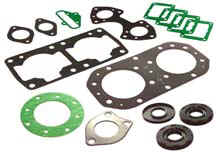How To Properly Cut A Gasket In 5 Easy Steps?
To properly cut a gasket, a few things need to be taken into consideration and a few steps need to be followed. With the right tools and a little bit of know-how, cutting a gasket can be a relatively straightforward process. Here are five easy steps to properly cut a gasket:
Select the Right Gasket Material
The first step in properly cutting a gasket is to select the right gasket material. There are a variety of different materials that can be used for gaskets, and each has its advantages and disadvantages. Some of the most common gasket materials include asbestos, neoprene, nitrile, and silicone. Asbestos is a durable material that can withstand high temperatures, but it is also a carcinogen. Neoprene is a synthetic rubber that is resistant to oil and weathering, but it can deteriorate in sunlight. Nitrile is a synthetic rubber that is resistant to oil and chemicals, but it can become brittle in cold temperatures. Silicone is a synthetic rubber that is resistant to high temperatures and chemicals, but it can be difficult to work with.
Cut the Gasket to the Correct Size
Once the correct gasket material has been selected, the next step is to cut the gasket to the correct size. The size of the gasket will depend on the application for which it is being used. Gaskets can be cut to any size, but it is important to make sure that the gasket is large enough to seal the area completely. If the gasket is too small, it will not be able to create an effective seal.
Bevel the Edges of the Gasket
After the gasket has been cut to the correct size, the next step is to bevel the edges of the gasket. Beveling the edges of the gasket will help to create a better seal. When beveling the edges of the gasket, it is important to use a sharp knife so that the edges are clean and smooth.
Body Title: Clean the Surfaces to be Sealed
Before installing the gasket, it is important to clean the surfaces to be sealed. Any dirt, grease, or other contaminants on the surface can prevent the gasket from creating an effective seal. The best way to clean the covers is to use a solvent such as acetone or alcohol.
Install the Gasket
The final step in properly Cut Gaskets is to install the gasket. The installation process will vary depending on the application for which the gasket is being used. In most cases, the gasket can be installed with adhesive or by using bolts or other fasteners. Once the gasket has been installed, it is important to check that the seal is secure and there are no leaks.
Conclusion:
Cutting a gasket is a relatively easy process, but there are a few things that need to be taken into consideration to do it properly. The first step is to select the right gasket material. There are a variety of different materials that can be used for gaskets, and each has its advantages and disadvantages. Once the correct gasket material has been selected, the next step is to cut the gasket to the correct size. The size of the gasket will depend on the application for which it is being used. After the gasket has been cut to the correct size, the next step is to bevel the edges of the gasket. Beveling the edges of the gasket will help to create a better seal. Before installing the gasket, it is important to clean the surfaces to be sealed. Any dirt, grease, or other contaminants on the surface can prevent the gasket from creating an effective seal. The final step in properly cutting a gasket is to install the gasket. The installation process will vary depending on the application for which the gasket is being used. In most cases, the gasket can be installed with adhesive or by using bolts or other fasteners. Once the gasket has been installed, it is important to check that the seal is secure and there are no leaks.





Comments
Post a Comment